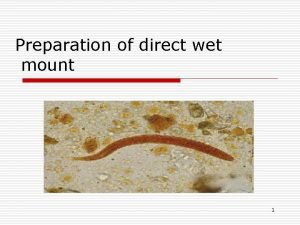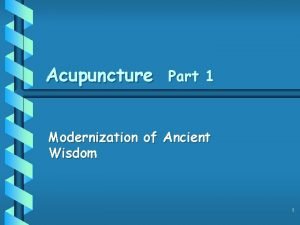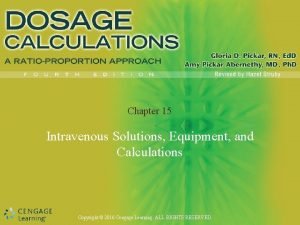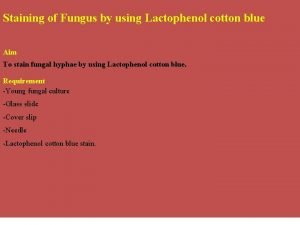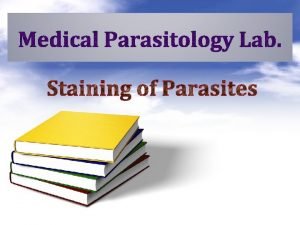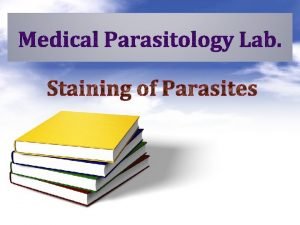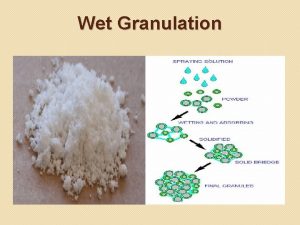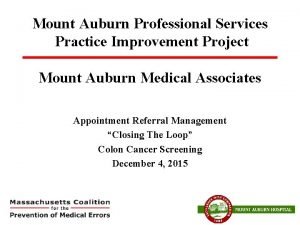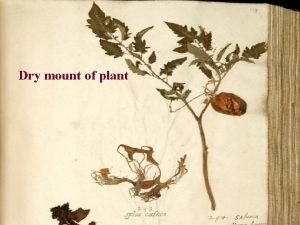wet mounts A Saline wet mount In saline






























- Slides: 30


wet mounts A. Saline wet mount: • In saline wet mount, trophozoites and cyst of amoeba, flagellates and ciliate may be seen. • Cyst will appear as round or oval, refractile structure. • Trophozoite of amoeba may be round or irregular, but trophozoite of flagellate are usually pyriform (elongated, pear- shaped). • In freshly passed feces (the stool must not be more than 1 hour old), motile trophozoites may be seen. • Motility can be seen very helpful in identifying species, especially in case of flagellates.

• Organism may be detected with the low power (10 x) objective, but a high power (40 x) dry objective will be necessary to identify reliable the structure as a cyst or trophozoite. • With the high power dry objective, you can see motility, inclusions like erythrocytes and yeast in amoebic trophozoites, chromatoid bodies in amoebic cyst. • Also, we can see the shape and structural detail (sucking discs, spiral grooves, or filaments) of flagellate trophozoites and cysts. • However, it’s necessary to regulate carefully the microscope illumination so that the objects appear clearly.

• Too much or too little light will interfere with your observations. • It’s also necessary to focus up and down to see all the layer of the specimen. • Remember to examine the whole coverslip area in a systematic manner to reduce the chances of overlooking organisms.

• B. Iiodine wet mount: • Iodine wet mount are examined for amoebic and flagellate cysts but not trophozoites because it’s killed by iodine. • In the iodine wet mount, cytoplasm of the cyst will stain yellow or light brown, and nuclei will stain dark brown. • Cyst stained with iodine can be detected with 10 x objective, but they are not refractile as in saline mount. 40 x used to see the characteristics of the cysts.

• In iodine stained cysts of Entamoeba, the arrangement of peripheral chromatin and the position of karyosome can be seen. If the peripheral chromatin isn’t present, the cyst is not an Entamoeba spp. These peripheral chromatin bodies stain light yellow. • Sometimes, young cysts contain glycogen, this stains dark brown with iodine. C. Buffered Methylene Blue wet mount: • If you see amoebic trophozoites, or structures that resemble trophozoites, you should prepare and examine BMB mount. • In the trophozoites, the nucleus and inclusion (RBC, yeast) will stain dark blue while the cytoplasm will stain light blue.

• After 5 -10 minutes of staining, the trophozoite sometimes remain motile, but often curl up in BMB preparation. For that do not confuse curled trophozoites with cysts do not stain with BMB solution. • Occasionally, some trophozoite will not stain, so you should look for well- stained organisms. • Look for peripheral nuclear granules (granules in membrane around the nucleus), if these are present, the trophozoite is an Entamoeba ssp. and you must identify the species.

Helminthes in wet mount • Eggs may be easily detected and identified in saline mounts. • They should not be stained (stains may interfere with identification). • Most eggs are large enough to be recognized with the low power (10 x) objective, but a few small eggs will require a high power dry lens (40 x) objective. • In saline mounts, larvae may be present, and it’s easily recognized with 10 x objective.

Continue ……. • In saline mounts, larvae of Strongyloides stercoralis may be seen, but Hookworm larvae are not usually present if the sample is fresh. • If the sample is old and contain Hookworm infection, then larvae may be present. • SO, it may be necessary to distinguish between these two species. ACTIVITY • FIND THE WAYS TO DIFFERENTIATE BETWEEN SPECIES IN OLD SAMPLES.

Liver Flukes • Fashiola spp.

Fasciola hepatica • Fasciola hepatica lives in the liver of man. • Fasciola spp. have many stages: • Oval eggs have miracidium, cercaria, metcercaria, larvae and adult stage. • Intermediate host: Snail. • Definitive host: human. • Infective stage (human): Metacercaria. • Reservoir stage: sheep. • Human infected by ingestion metacercaria from infected sheep. • Diagnosis: • Stool analysis to find Fasciola egg.


Fasciola hepatica Egg

Fasciola hepatica Miracidium

Fasciola hepatica cercariae

Fasciola hepatica rediae larvae

Fasciola hepatica Adult

Blood Flukes Schistosoma spp.

Schistosoma spp. • Also known as bilharzia, cause schistosomiasis or bilhariziasis. • Schistosoma spp. have 4 stages: Eggs, miracidia, cercaria, and adult stage. • Eggs are passed through urine or feces to fresh water, where larvae stage can infect a new host by penetrating the skin. • Schistosoma eggs are non- operculated but spined and have miracidum. Eggs hatch and release miracidia in water. • Miracidia move in water looking for a special snail, and penetrate a snail tissue and developed to sporocyst. • Cercaria releasaed by snail into water and free swimming, cercaria has a bifid tail and penetrate intact skin • Cercaria lose tail during penetration and become schitosomulae, that circulate in the blood and migrate to portal blood of liver and mature into adult.

Raed Z. Ahmed, Medical Parasitology Lab. , 2012

Schistosoma spp. (cont…. ) • There are three medically important species: • Schistosoma mansoni, lives in the mesenteric venules of large intestine, and cause intestinal bilharziasis. • Schistosoma japonicum, lives in the mesenteric venules of small intestine. • Schistosoma haematobium, lives in the venous plexus of the urinary bladder and cause schistosomal hematuria or urinary bilhariziasis. • S. mansoni and S. japonicum are produce their eggs in stool, but S. haematobium produce eggs in urine.

• Intermediate host: snail. • Definitive host: human. • Cercaria is the infective stage but eggs are the diagnostic stage. • Diagnosis: • Depends on finding the characteristic ova in feces or urine. • Three species can be distinguished by the appearance of their eggs under microscope: • S. mansoni eggs have prominent lateral spine. • S. japonicum eggs have a very small round lateral spine. • S. Haematobium eggs have a terminal spine.

Snail for Schistosoma spp. Schistosome species Snails S. haematobium Bulinus spp. S. mansoni Biomphalaria spp. S. japonicum Oncomelania spp.

Snail Biomphalaria spp. Oncomelania spp. Bulinus spp.

Schistosoma spp. Eggs S. mansoni S. haematobium S. japonicum Lateral spine Terminal spine Rounded spine

Schistosoma miracidium

Schistosoma cercaria Oval head Bifid tail

Schistosoma adult male Adult male short, thick and have gynaecophoric canal

Schistosoma adult female Adult female longer and thinner than adult male.

Gynaecophoric canal
 Wet wet wet
Wet wet wet Senile carious lesions
Senile carious lesions Mounts classification
Mounts classification How to make a wet mount slide
How to make a wet mount slide Cover slip drawing
Cover slip drawing Direct wet mount
Direct wet mount Yeast buds on wet mount
Yeast buds on wet mount Lactated ringers vs normal saline
Lactated ringers vs normal saline Saline meaing
Saline meaing Lung compliance graph
Lung compliance graph Drop factor constant
Drop factor constant Saline district library
Saline district library Schéma pile volta
Schéma pile volta Saline solution boots
Saline solution boots Normal saline order example
Normal saline order example Formal saline fixative
Formal saline fixative Saline soil
Saline soil Saline cathartics
Saline cathartics Lactated ringers vs normal saline
Lactated ringers vs normal saline Saline cathartics
Saline cathartics Phenylephrine dosage
Phenylephrine dosage Isolyte p composition
Isolyte p composition Mount merapi facts
Mount merapi facts Thin mount ribbons
Thin mount ribbons Blackberry trail mount rushmore
Blackberry trail mount rushmore Lactophenol cotton blue stain procedure
Lactophenol cotton blue stain procedure Mount sinai adolescent clinic
Mount sinai adolescent clinic G j mount classification
G j mount classification Legal assistance services townsville
Legal assistance services townsville Mount grace school uniform
Mount grace school uniform Baildon ward lynfield mount
Baildon ward lynfield mount





